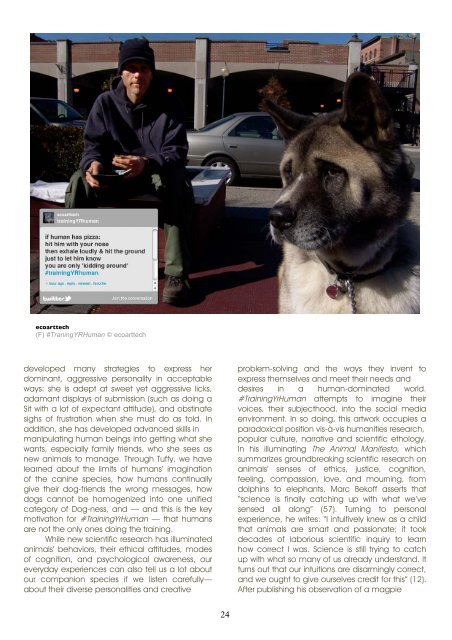Animal Influence I - Antennae The Journal of Nature in Visual Culture
Animal Influence I - Antennae The Journal of Nature in Visual Culture
Animal Influence I - Antennae The Journal of Nature in Visual Culture
Create successful ePaper yourself
Turn your PDF publications into a flip-book with our unique Google optimized e-Paper software.
ecoarttech<br />
(F) #Tran<strong>in</strong>gYRHuman ecoarttech<br />
developed many strategies to express her<br />
dom<strong>in</strong>ant, aggressive personality <strong>in</strong> acceptable<br />
ways: she is adept at sweet yet aggressive licks,<br />
adamant displays <strong>of</strong> submission (such as do<strong>in</strong>g a<br />
Sit with a lot <strong>of</strong> expectant attitude), and obst<strong>in</strong>ate<br />
sighs <strong>of</strong> frustration when she must do as told. In<br />
addition, she has developed advanced skills <strong>in</strong><br />
manipulat<strong>in</strong>g human be<strong>in</strong>gs <strong>in</strong>to gett<strong>in</strong>g what she<br />
wants, especially family friends, who she sees as<br />
new animals to manage. Through Tuffy, we have<br />
learned about the limits <strong>of</strong> humans’ imag<strong>in</strong>ation<br />
<strong>of</strong> the can<strong>in</strong>e species, how humans cont<strong>in</strong>ually<br />
give their dog-friends the wrong messages, how<br />
dogs cannot be homogenized <strong>in</strong>to one unified<br />
category <strong>of</strong> Dog-ness, and — and this is the key<br />
motivation for #Tra<strong>in</strong><strong>in</strong>gYrHuman — that humans<br />
are not the only ones do<strong>in</strong>g the tra<strong>in</strong><strong>in</strong>g.<br />
While new scientific research has illum<strong>in</strong>ated<br />
animals’ behaviors, their ethical attitudes, modes<br />
<strong>of</strong> cognition, and psychological awareness, our<br />
everyday experiences can also tell us a lot about<br />
our companion species if we listen carefully—<br />
about their diverse personalities and creative<br />
24<br />
problem-solv<strong>in</strong>g and the ways they <strong>in</strong>vent to<br />
express themselves and meet their needs and<br />
desires <strong>in</strong> a human-dom<strong>in</strong>ated world.<br />
#Tra<strong>in</strong><strong>in</strong>gYrHuman attempts to imag<strong>in</strong>e their<br />
voices, their subjecthood, <strong>in</strong>to the social media<br />
environment. In so do<strong>in</strong>g, this artwork occupies a<br />
paradoxical position vis-à-vis humanities research,<br />
popular culture, narrative and scientific ethology.<br />
In his illum<strong>in</strong>at<strong>in</strong>g <strong>The</strong> <strong>Animal</strong> Manifesto, which<br />
summarizes groundbreak<strong>in</strong>g scientific research on<br />
animals’ senses <strong>of</strong> ethics, justice, cognition,<br />
feel<strong>in</strong>g, compassion, love, and mourn<strong>in</strong>g, from<br />
dolph<strong>in</strong>s to elephants, Marc Bek<strong>of</strong>f asserts that<br />
“science is f<strong>in</strong>ally catch<strong>in</strong>g up with what we’ve<br />
sensed all along” (57). Turn<strong>in</strong>g to personal<br />
experience, he writes: “I <strong>in</strong>tuitively knew as a child<br />
that animals are smart and passionate; it took<br />
decades <strong>of</strong> laborious scientific <strong>in</strong>quiry to learn<br />
how correct I was. Science is still try<strong>in</strong>g to catch<br />
up with what so many <strong>of</strong> us already understand. It<br />
turns out that our <strong>in</strong>tuitions are disarm<strong>in</strong>gly correct,<br />
and we ought to give ourselves credit for this” (12).<br />
After publish<strong>in</strong>g his observation <strong>of</strong> a magpie












